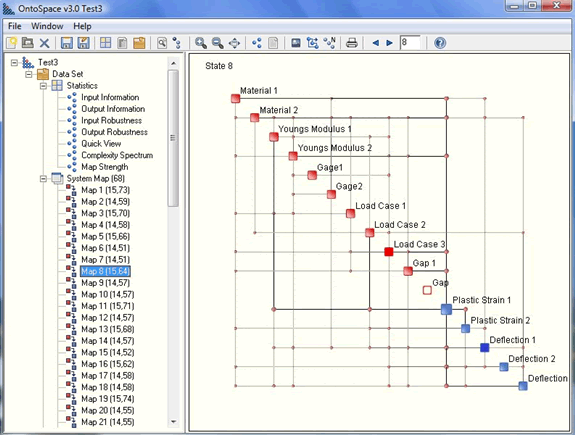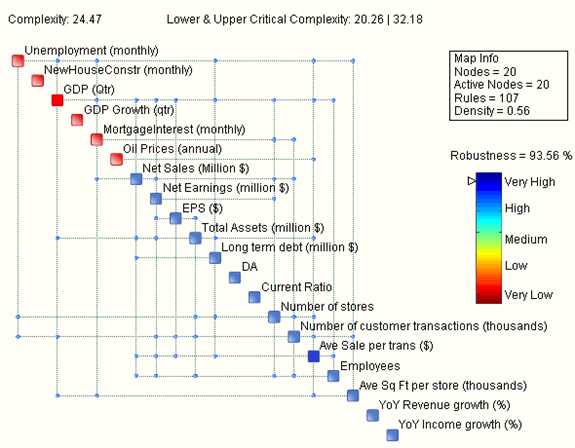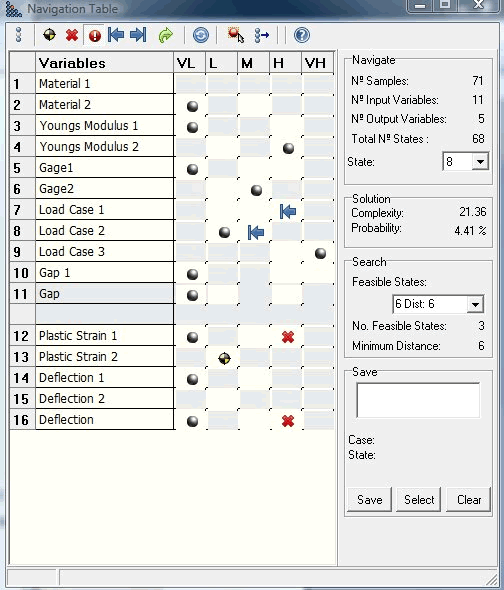Using OntoSpace v3.0 to Avoid Design Complexity
By comparing designs, you can manage complexity and minimize risk.
Latest News
March 5, 2008
By DE Editors
Ontonix (Novi, MI) explains that avoiding design complexity in RP&M is not only possible, but measurable, and by so doing you increase the credibility of your model. The company’s recent release, OntoSpace version 3.0, does just that — it analyzes complex systems and provides a way to compare designs working with time-dependent data from computer models, sensors, or historical records.
Without requiring any mathematical training or statistical knowledge, OntoSpace’s calculation method lets you specify target stresses, displacements, or masses, and suggests ways to change a design to ensure it reaches prescribed values. The goal is to help you manage complexity so that you can build complex designs that are durable.
“Is it possible to actually measure the level of credibility of a computer model? The answer to this fundamental, yet often embarrassing question, is a resounding yes,” says Jacek Marczyk, chief technology officer of Ontonix. “With complexity technology from Ontonix, a single physical test and a single simulation are sufficient to quantify the level of trust of a given computer model.”

While OntoSpace v 3.0 is characterized by a completely renovated graphical user interface (GUI) and improved memory management, it also incorporates a new proprietary algorithm that ranks variables in a robust fashion. And, in the end, designs that are more robust are often less complex.
The credibility of a computer model — that is, your level of trust that the model results are accurate — can be measured through both physical tests and computer simulations. OntoSpace v 3.0 extends your understanding of your testing by creating test maps and simulations maps that provide insights to how you can make changes that will make your whole process more efficient.

For instance, consider what it means to reduce design cycle times through faster iterative analysis. It means you can reduce “the number of physical prototypes required for design validation; and ]improve] accuracy to drive down product, development, manufacturing, and warranty costs,” as stated on the NAFEMS website.
Such efficiency plays out in three possible scenarios, according to Ontonix.
1. The complexities are similar: your model is good and credible.
2. The test results prove to be more complex than simulation results: your model misses physics or is based on wrong assumptions.
3. The simulation results prove to be more complex than the physical test results: your model probably generates noise.
“The issue of model validation is extremely critical and yet, at the same time, it represents the most neglected aspect of digital simulation,” Marczyk adds. “Knowing how much one can trust a digital model is of paramount importance.”
With its ability to process time-dependent data, OntoSpace v3.0 is not only described as an advanced business intelligence and corporate performance management (BI-CPM) tool, but is said to make it possible to perform real-time monitoring of the complexity of dynamic systems.
This is the ability that establishes OntoSpace v3.0 as a holistic pre-alarm system, says the company. When the complexity of a given system approaches a certain threshold, a warning may be issued, indicating an increased level of fragility.
“Because of its ability to process time-dependent data,” says Marczyk, “OntoSpace v3.0 offers all the necessary ingredients in order to set new standards.”
For example, OntoSpace’s Interactive Navigation Table allows users to navigate their N-dimensional data and to perform what-if analyses. The process is said to be very easy — the user specifies equality or inequality constraints, defines targets (desired values) for certain variables, and triggers the search for all conditions under which constraints and targets are satisfied.

At each step (time window), OntoSpace provides the user with vital information such as an interactive process map; current, upper, and lower complexity bounds; robustness (state-of-health) and risk exposure; ranked scatter plots (ranking is based on mutual entropy); information content for each variable; robustness of each variable; local statistics; quick view for fast and interactive data navigation; and a comprehensive HTML report.
| “The issue of model validation is extremely critical and yet, at the same time, it represents the most neglected aspect of digital simulation. Knowing how much one can trust a digital model is of paramount importance.” —Jacek Marczyk, Ontonix, CTO |
In addition to determining the most robust design in complexity-based CAD/CAE, OntoSpace is used in areas such as merger analysis, air-traffic management, sociology and politics, medicine, and banking. The specific functions that address these applications include advanced risk management (financial, operational, or credit risk); business process management (business diagnosis); corporate performance monitoring; genomics (generation of metabolic or genetic networks); advanced system monitoring (stock-market); industrial process analysis; defense; logistics, traffic monitoring and diagnosis; conflict anticipation and identification of failing states; accident/vulnerability analysis (insurance risk).
Finally, OntoSpace is said to be the first commercial software tool for comprehensive and practical quantification and management of complexity. Its approach to complexity and its quantification establishes a different approach to BI-CPM, management, decision-making, and controlling risk as well as robust design.
Ultimately, the measure of model credibility, or level of trust, can now be quantified in a timely and technological fashion.
Click here for more information about Ontonix LLC and its complexity management services.
Click here to go straight to the landing page for OntoSpace v 3.0.
Click here to read why DE‘s editors made this a Pick of the Week.
Click here to read Ontonix Complexity Management’s explanation on Why Measure Complexity? The link to the online trial is near the end.
Link to datasheet on OntoSpace: Measuring and Managing Complexity
Click here to view the spectrum of Applications for OntoSpace v 3.0s.
Click here to read How to Avoid Design Complexity …
Click here to access links to additional sources of information.
Click here to read an article by Jacek Marczyk in DE’s Elements of Analysis (Mar ‘08) questioning the accuracy of car-crash testing based on his research.
Click here to visit the NAFEMS Stochastic Working Group (SWG).
Subscribe to our FREE magazine, FREE email newsletters or both!
Latest News
About the Author
DE’s editors contribute news and new product announcements to Digital Engineering.
Press releases may be sent to them via [email protected].






